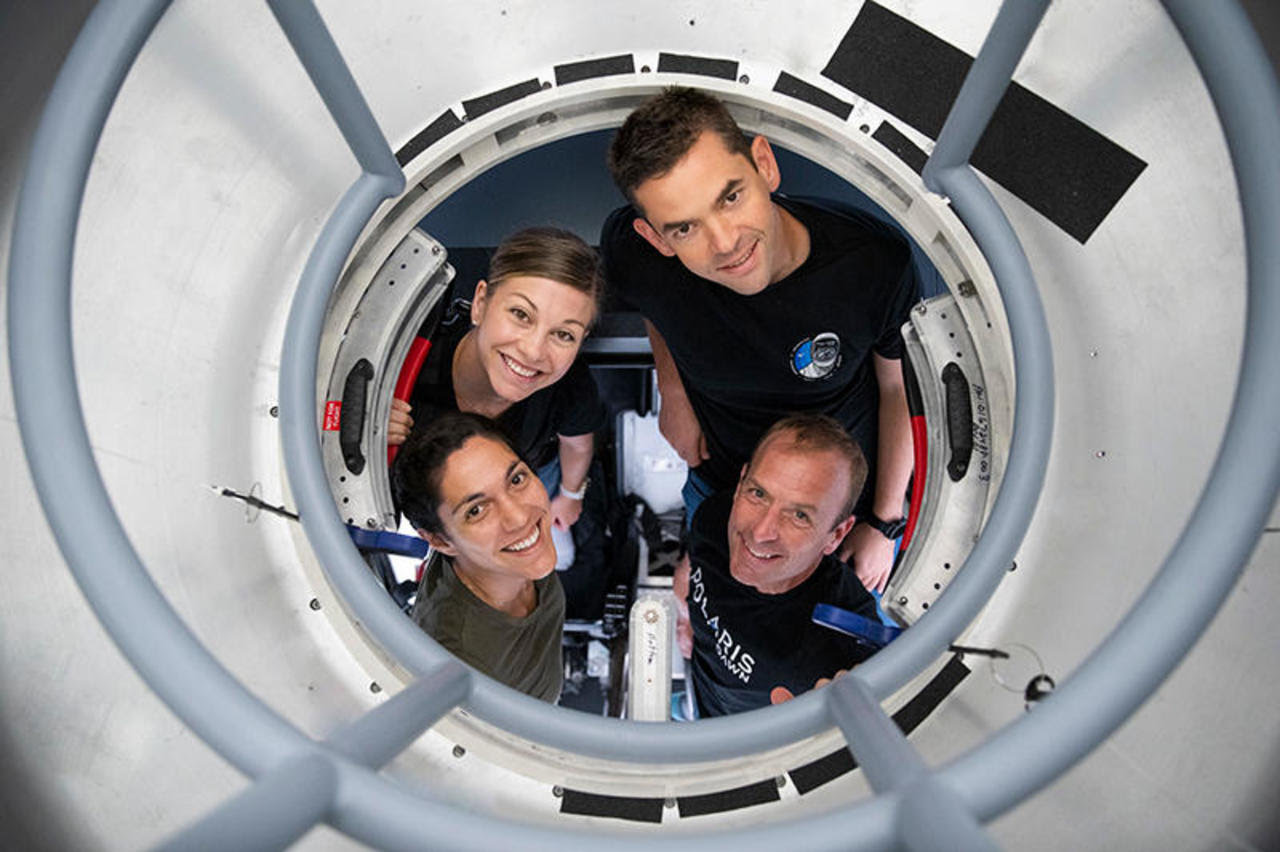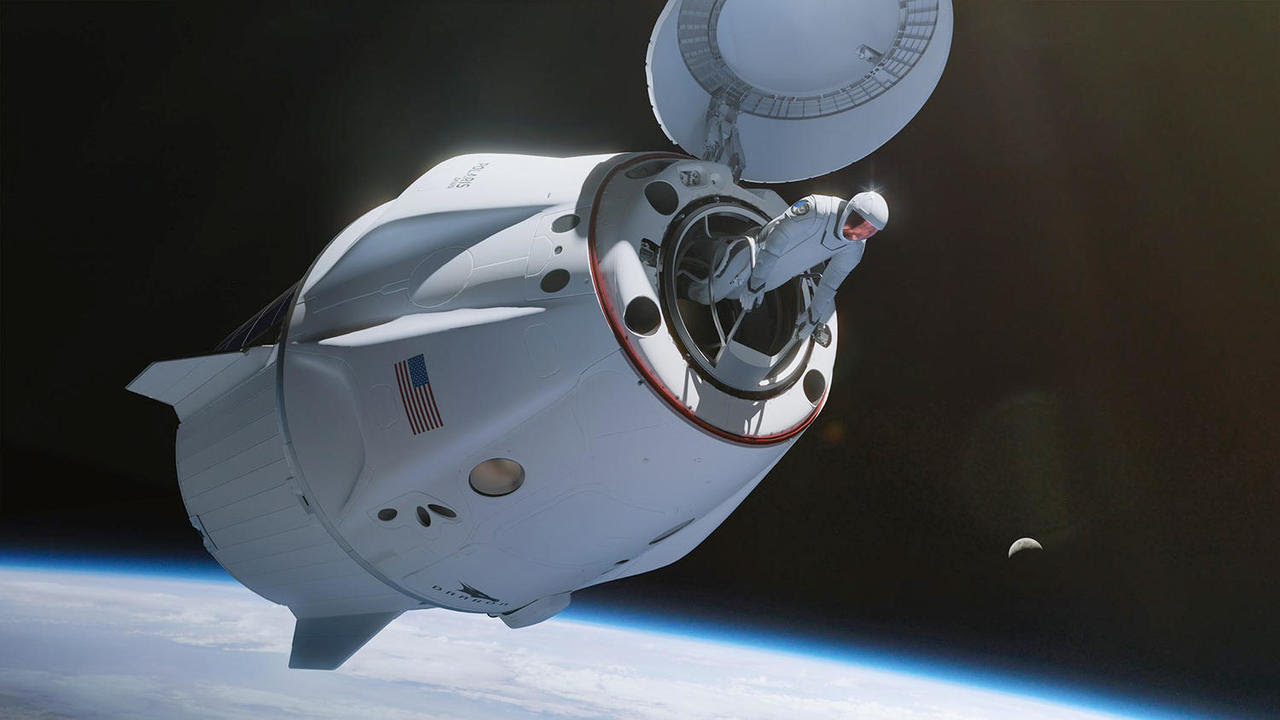Billionaire Jared Isaacman and SpaceX crew trainer Sarah Gillis are set to make history by conducting the first non-governmental spacewalk.
The pair, along with their crewmates Anna Menon and Scott Poteet, launched aboard the Polaris Dawn mission and are expected to float outside their spacecraft Thursday morning.
This marks the first time a commercial crew has conducted a spacewalk without government oversight.
While Isaacman and Gillis step outside the SpaceX Crew Dragon capsule, Menon and Poteet will monitor from inside, ensuring all safety protocols, including tether management and oxygen umbilicals, are followed. The spacewalk officially began at 6:12 a.m. EDT, when their pressurized spacesuits were activated.
The crew will use a “Skywalker” scaffold attached to the hatch for stability as they float in space. Unlike traditional spacewalks, Isaacman and Gillis will not free-float; their suits are tethered to the spacecraft through a 12-foot umbilical system for air, power, and communication.

According to CBS News, the primary focus is to test the mobility and comfort of SpaceX’s custom-designed extra-vehicular activity (EVA) suits, which could one day be used for missions to the moon or Mars.
“We’re going to make use of various mobility aids the SpaceX team has engineered, and it’ll look like we’re doing a little bit of a dance,” Isaacman said before launch. “The idea is to learn as much as we possibly can about this suit and get it back to the engineers to inform future suit design evolutions.”
Cameras both inside and outside the spacecraft will capture the moment as the team orbits Earth at altitudes reaching 458 miles, significantly higher than the International Space Station.
The data collected will aid in developing affordable, mass-producible spacesuits for future commercial astronauts.
The five-day mission, which began with a launch aboard a SpaceX Falcon 9 rocket from Kennedy Space Center, has already achieved its first milestone, reaching a record altitude of 870 miles—the highest since NASA’s Apollo missions.
As the mission continues, the crew’s ultimate goal is to pave the way for future commercial space endeavors, including potential lunar and Mars explorations.
“I think that this journey of creating affordable EVA suits that can be scaled up into mass production is a very worthwhile one,” said Isaacman, who chartered SpaceX’s first fully commercial flight to orbit in 2021. “There’s going to be an armada of Starships arriving on Mars at some point in the future, and those people are going to have to be able to get out of it and walk around and and do important things.”
Isaacman, Poteet, Menon, and Gillis launched from the Kennedy Space Center on Tuesday aboard a SpaceX Falcon 9 rocket. The crew hit a major milestone early in the mission, reaching an altitude of 870 miles—making it the highest piloted flight since the Apollo moon missions over 60 years ago.
After reaching this record altitude, the crew lowered their orbit to 458 miles in preparation for their upcoming spacewalk and the rest of their five-day mission.

To avoid decompression sickness, or “the bends,” as they transitioned from normal atmospheric pressure to the reduced 5 psi inside their spacesuits, flight controllers initiated a careful 45-hour process. This included gradually increasing the oxygen levels in the spacecraft while slowly lowering the air pressure to flush nitrogen from the crew’s bloodstreams.
“We’re not expecting to experience decompression sickness thanks to the extensive planning and the detailed pre-breathe protocol we’ve developed,” said Menon, a former NASA biomedical flight controller. “But if needed, we’re fully prepared.”
Because the Crew Dragon capsule doesn’t have an airlock and wasn’t originally designed for spacewalks, a number of upgrades were necessary. These included boosting the oxygen supply to accommodate four spacesuits through umbilicals during the spacewalk, as well as enhancing the environmental monitoring systems to ensure accurate readings before, during, and after the exposure to space.
Gillis explained, “We’ve added a new nitrogen repressurization system to return the cabin to normal levels after the spacewalk, along with other modifications like a motorized hatch opener, enhanced seals for airtightness, and a ‘Skywalker’ scaffold to extend from the hatch for support.”
NASA’s first U.S. spacewalk was conducted in 1965 by astronaut Ed White, who famously floated outside the Gemini 4 capsule tethered to a long line. Since then, over 470 government-sponsored spacewalks have been performed by astronauts and cosmonauts from NASA, Russia, China, and space station partner nations.
While inspired by photos of White’s historic spacewalk, Isaacman and Gillis have opted for a more controlled approach during their mission, foregoing the “free-floating” experience in favor of gathering useful data about their SpaceX suits.
“We’re not going to be doing the Ed White float,” Isaacman told CBS News before launch. “That might look cool, but it doesn’t really help SpaceX learn a lot about the performance (of the spacesuit). It’s not very useful or helpful for figuring out how to be able to to work in a suit.”
As part of this, Isaacman and Gillis will perform various movements in their pressurized suits to test the joints’ flexibility and overall mobility. They’ll also evaluate the heads-up display embedded in the helmet and assess how well the suit manages extreme temperatures in space.
The spacesuit, Gillis added, “is equipped with all kinds of technology, from a heads-up display and helmet camera to an advanced joint mobility architecture. It’s insulated with thermal protection, including a copper and indium tin oxide visor, which shields us from both thermal and solar radiation.”
Safety features like oxygen redundancy and multiple backup systems have been incorporated into the suit to ensure the crew’s well-being during the spacewalk. The heads-up display, a feature lacking in NASA’s older spacesuits, will allow real-time monitoring of critical data such as suit pressure, temperature, and oxygen consumption.
Isaacman’s Polaris Dawn mission is the first of three planned in collaboration with Elon Musk’s SpaceX. The second mission will involve another Crew Dragon flight, followed by the first piloted mission aboard SpaceX’s Super Heavy-Starship rocket, which is still in development.
While the exact costs of the missions remain undisclosed, Isaacman, a businessman and jet pilot, confirmed that no financial details would be shared. This mission, SpaceX’s fifth commercial Crew Dragon flight, is expected to conclude after five days with a splashdown off the coast of Florida.











